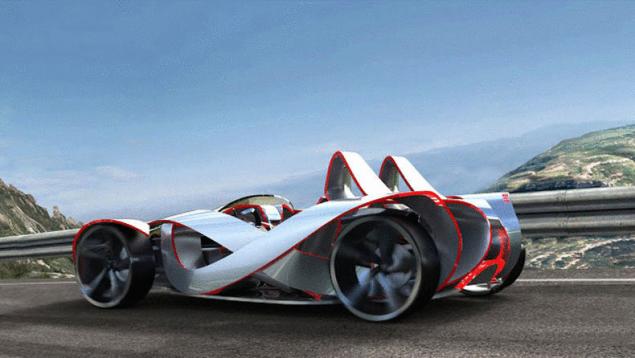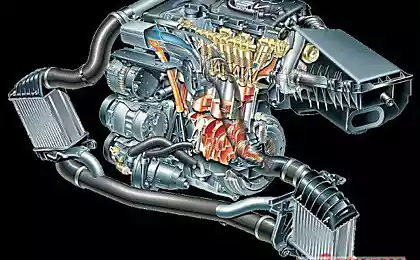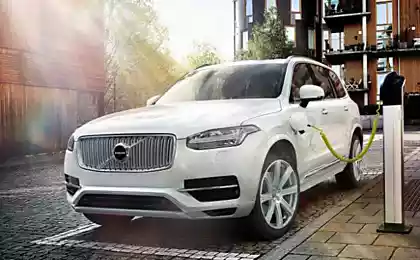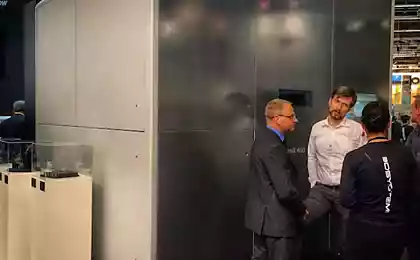502
What technologies can replace electric cars
Humanity is banal are not ready for the development of electric vehicles: we still have had neither the resources nor the technology to effectively implement this idea.
But because of this "power hysteria" alternatives many people simply do not notice.
Pure electric car yet – utopia. He is too little goes and long charges. And charge it, in General, nowhere and nothing, because the infrastructure network is still far from perfect, and with a generating capacity in the world, the situation is not too good. In the end, in order to generate electricity we continue to burn hydrocarbons. So what, one wonders, is the difference, where they will be burnt in combustion engines or in furnaces of thermal power plants?

However, manufacturers are vying report about their achievements. The same "Nissan", for example, recently boasted 145% growth in the sales LEAF. And all anything, but talking about monthly results, if we consider the absolute figures that we are talking only about 650 cars...
The only really cool modern electric car – Tesla Model S, though, because he accelerates like a sports car, moreover, the actual range is 200 miles. However, to judge how good he is we will be able in a year and a half, when the first cars sold wound on 100,000 miles on the speedometer. For example, the LEAF battery with the same run lose 20% of their capacity. In Model S there is no such problem, but not the fact that they will not...
Hybrids were the first, moreover, they are still dominant in the environmental segment, but at the same time, it's clear that soon the direction will rapidly die. There are several reasons: first, used in the circuit of the internal combustion engine, and secondly, the low efficiency, and thirdly, high mass, fourthly, extremely small margin of "zero" turn.
And yet, hybrid cars are still able to not only strengthen its position, but seriously push pure electric cars. They, however, have to be transformed, but the scheme worked for a long time. Ice does not disappear, but the unit is intended for direct propulsion, it will turn into a generator, pozarastali battery.
Now such machines are called "electric vehicle with extended range". This scheme is on the one hand allows the car to provide an acceptable radius, and "decouple" it from the network charges, that is, to solve the main performance problems of traditional electric. But at the same time, on the "zero" exhaust is there to say no, because the engine is switched on permanently (on acceleration, high load side on the grid) and not only when the driver is fully planted stock batteries.
The price tag for such a car, of course, also higher, and even while not the cheapest electric cars. However, this is the most likely direction of development of ecological transport today.
Many environmentalists and experts believe that the hydrogen car – only correct the future of the global automobile industry. Cars running on fuel cells are already being tested in various regions, however, despite the fact that closely this theme auto industry started at about the same time he began studying electric vehicles, distributed hydrogen cars much less.
The fact, however, there are also quite objective reasons. Among the pros: good range (the prototypes up to 500 kilometers), fast fill (3-5 minutes)... the Only exhaust that is water vapor.
But at the same time, hydrogen cars are too expensive. For example, cars like the Toyota FCV retail today would cost no less than $ 50 000. This is 25% more than asking for the BMW i3. Nissan LEAF at all is twice cheaper. In addition, it is not the drivers ' car – power plants rarely exceeds 100 kW (136 HP).
And yet, if mankind needed ecologically clean transport, fuel cells – almost perfect, though, because they are moving due to a chemical reaction and they do not need to generate electricity.
In the fall of 2012, the British newspaper the Independent gave the note, which told about a group of British scientists of "Air Fuel Synthesis", developed a unique technology for the production of fuel from... the air, or rather of its contained carbon dioxide and water vapor. At that time the "catch" was small – synthesize therefore, the company could only 5 liters of fuel. But in General the technology can be called revolutionary because it involves the disposal into the atmosphere of carbon dioxide.
After the demonstration results in "Air Fuel Synthesis" began search of the investor which would give 5-6 million pounds in the second stage of the project (first funded working on the "Shell" Professor Tony Marmont, who invested in the personal development of 1.2 million).
Given that about "Air Fuel Synthesis" in wider circles since then not heard anything, investors apparently found. And, most likely, they became one of the largest oil and gas corporations. However, the fact that the oil companies will clean up technology to the hands, no doubt. The fact that the production of "atmospheric" fuel was not so expensive. According to the calculations worked on the project of chemists, the industrial production of a ton of gasoline obtained in this way will cost 400 pounds. Of course, it is more expensive than a ton of gasoline obtained from fossil oil, but not significantly.
"Electric" methane
A pioneer in this field was the company "Audi", undertaken for the implementation of the program with the modest title of Audi balanced mobility, aimed at achieving a neutral balance in carbon dioxide throughout the life of the vehicle, starting from time of production to time of disposal.
Moreover, the e-gas can partly be regarded as a hydrocarbon, since we are talking about the development of synthetic... methane! This gas is itself one of the most bystrovozvodimyh of hydrocarbons on the planet. However, the synthetic methane, according to the Germans, will allow to save the Earth from greenhouse gases. The point is that in its formulation the reaction is carried out using water and carbon dioxide and thus prevents the flow of the latter into the atmosphere. As a result, we get vicious, in fact, the circulation of CO2.
The only exhaust in the first stage is oxygen and the second with distilled water. In addition, the hydrolysis allows to produce hydrogen, which in turn is also a source of energy and in the medium term can be used in cars with fuel cells.
In General, along with the development of hydrogen vehicles, this scheme looks more than promising, because that-that, and the stocks of CO2 on the planet ever runs out. In addition, this technology is interesting also there that in fact it allows Autonomous gasification of private house, street or village. The only condition – the presence of electricity.
However, it has a couple of significant drawbacks. The first is electrolysis, a process which in itself is very energy consuming. That is, for this project we need the mass introduction of more environmentally friendly production of electricity. The second is CO2. Technologies that can take carbon dioxide directly from the atmosphere does not yet exist. Audi built its plant near the enterprise for the production of biofuel, where it is a by-product, so the neighborhood turned out mutually beneficial: the excess heat generated during methanation are used for the production of biogas, and from there to the plant comes highly concentrated CO2. Different technology doesn't work yet.
Liquid oxygen
There is a company "Dearman Engine", which is trying to improve the engine running on...the air. More specifically, to a cryogenic source, using energy released during heating of a liquid and its conversion into steam.
So we're talking about conventional engine, with pistons and connecting rods, crankshaft... However, in its combustion chamber receives no fuel and liquid oxygen (or nitrogen) temperature of nearly 200 degrees below zero. After the cylinder is injected normal water or air. The reaction mixture heats up and expands and pushes the piston.
Standard cycle, but emissions of water vapour. The developers claim that this work is not only more environmentally friendly, but also quite effective. Moreover, so effective that demand the presence of such motors without problems can be installed on heavy trucks.
The massive use of technology in freight transport will allow you to save more than 10 billion liters of diesel fuel in Europe alone. Moreover, if there is demand and related investments to put your motor on the conveyor in "Dearman Engine" promise almost two years.
Source: newsland.com
But because of this "power hysteria" alternatives many people simply do not notice.
Pure electric car yet – utopia. He is too little goes and long charges. And charge it, in General, nowhere and nothing, because the infrastructure network is still far from perfect, and with a generating capacity in the world, the situation is not too good. In the end, in order to generate electricity we continue to burn hydrocarbons. So what, one wonders, is the difference, where they will be burnt in combustion engines or in furnaces of thermal power plants?

However, manufacturers are vying report about their achievements. The same "Nissan", for example, recently boasted 145% growth in the sales LEAF. And all anything, but talking about monthly results, if we consider the absolute figures that we are talking only about 650 cars...
The only really cool modern electric car – Tesla Model S, though, because he accelerates like a sports car, moreover, the actual range is 200 miles. However, to judge how good he is we will be able in a year and a half, when the first cars sold wound on 100,000 miles on the speedometer. For example, the LEAF battery with the same run lose 20% of their capacity. In Model S there is no such problem, but not the fact that they will not...
Hybrids were the first, moreover, they are still dominant in the environmental segment, but at the same time, it's clear that soon the direction will rapidly die. There are several reasons: first, used in the circuit of the internal combustion engine, and secondly, the low efficiency, and thirdly, high mass, fourthly, extremely small margin of "zero" turn.
And yet, hybrid cars are still able to not only strengthen its position, but seriously push pure electric cars. They, however, have to be transformed, but the scheme worked for a long time. Ice does not disappear, but the unit is intended for direct propulsion, it will turn into a generator, pozarastali battery.
Now such machines are called "electric vehicle with extended range". This scheme is on the one hand allows the car to provide an acceptable radius, and "decouple" it from the network charges, that is, to solve the main performance problems of traditional electric. But at the same time, on the "zero" exhaust is there to say no, because the engine is switched on permanently (on acceleration, high load side on the grid) and not only when the driver is fully planted stock batteries.
The price tag for such a car, of course, also higher, and even while not the cheapest electric cars. However, this is the most likely direction of development of ecological transport today.
Many environmentalists and experts believe that the hydrogen car – only correct the future of the global automobile industry. Cars running on fuel cells are already being tested in various regions, however, despite the fact that closely this theme auto industry started at about the same time he began studying electric vehicles, distributed hydrogen cars much less.
The fact, however, there are also quite objective reasons. Among the pros: good range (the prototypes up to 500 kilometers), fast fill (3-5 minutes)... the Only exhaust that is water vapor.
But at the same time, hydrogen cars are too expensive. For example, cars like the Toyota FCV retail today would cost no less than $ 50 000. This is 25% more than asking for the BMW i3. Nissan LEAF at all is twice cheaper. In addition, it is not the drivers ' car – power plants rarely exceeds 100 kW (136 HP).
And yet, if mankind needed ecologically clean transport, fuel cells – almost perfect, though, because they are moving due to a chemical reaction and they do not need to generate electricity.
In the fall of 2012, the British newspaper the Independent gave the note, which told about a group of British scientists of "Air Fuel Synthesis", developed a unique technology for the production of fuel from... the air, or rather of its contained carbon dioxide and water vapor. At that time the "catch" was small – synthesize therefore, the company could only 5 liters of fuel. But in General the technology can be called revolutionary because it involves the disposal into the atmosphere of carbon dioxide.
After the demonstration results in "Air Fuel Synthesis" began search of the investor which would give 5-6 million pounds in the second stage of the project (first funded working on the "Shell" Professor Tony Marmont, who invested in the personal development of 1.2 million).
Given that about "Air Fuel Synthesis" in wider circles since then not heard anything, investors apparently found. And, most likely, they became one of the largest oil and gas corporations. However, the fact that the oil companies will clean up technology to the hands, no doubt. The fact that the production of "atmospheric" fuel was not so expensive. According to the calculations worked on the project of chemists, the industrial production of a ton of gasoline obtained in this way will cost 400 pounds. Of course, it is more expensive than a ton of gasoline obtained from fossil oil, but not significantly.
"Electric" methane
A pioneer in this field was the company "Audi", undertaken for the implementation of the program with the modest title of Audi balanced mobility, aimed at achieving a neutral balance in carbon dioxide throughout the life of the vehicle, starting from time of production to time of disposal.
Moreover, the e-gas can partly be regarded as a hydrocarbon, since we are talking about the development of synthetic... methane! This gas is itself one of the most bystrovozvodimyh of hydrocarbons on the planet. However, the synthetic methane, according to the Germans, will allow to save the Earth from greenhouse gases. The point is that in its formulation the reaction is carried out using water and carbon dioxide and thus prevents the flow of the latter into the atmosphere. As a result, we get vicious, in fact, the circulation of CO2.
The only exhaust in the first stage is oxygen and the second with distilled water. In addition, the hydrolysis allows to produce hydrogen, which in turn is also a source of energy and in the medium term can be used in cars with fuel cells.
In General, along with the development of hydrogen vehicles, this scheme looks more than promising, because that-that, and the stocks of CO2 on the planet ever runs out. In addition, this technology is interesting also there that in fact it allows Autonomous gasification of private house, street or village. The only condition – the presence of electricity.
However, it has a couple of significant drawbacks. The first is electrolysis, a process which in itself is very energy consuming. That is, for this project we need the mass introduction of more environmentally friendly production of electricity. The second is CO2. Technologies that can take carbon dioxide directly from the atmosphere does not yet exist. Audi built its plant near the enterprise for the production of biofuel, where it is a by-product, so the neighborhood turned out mutually beneficial: the excess heat generated during methanation are used for the production of biogas, and from there to the plant comes highly concentrated CO2. Different technology doesn't work yet.
Liquid oxygen
There is a company "Dearman Engine", which is trying to improve the engine running on...the air. More specifically, to a cryogenic source, using energy released during heating of a liquid and its conversion into steam.
So we're talking about conventional engine, with pistons and connecting rods, crankshaft... However, in its combustion chamber receives no fuel and liquid oxygen (or nitrogen) temperature of nearly 200 degrees below zero. After the cylinder is injected normal water or air. The reaction mixture heats up and expands and pushes the piston.
Standard cycle, but emissions of water vapour. The developers claim that this work is not only more environmentally friendly, but also quite effective. Moreover, so effective that demand the presence of such motors without problems can be installed on heavy trucks.
The massive use of technology in freight transport will allow you to save more than 10 billion liters of diesel fuel in Europe alone. Moreover, if there is demand and related investments to put your motor on the conveyor in "Dearman Engine" promise almost two years.
Source: newsland.com























